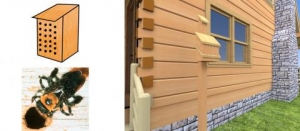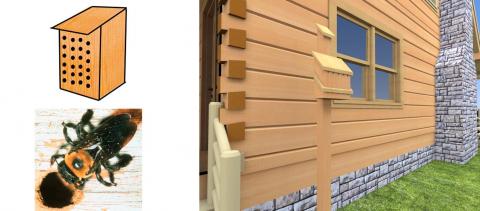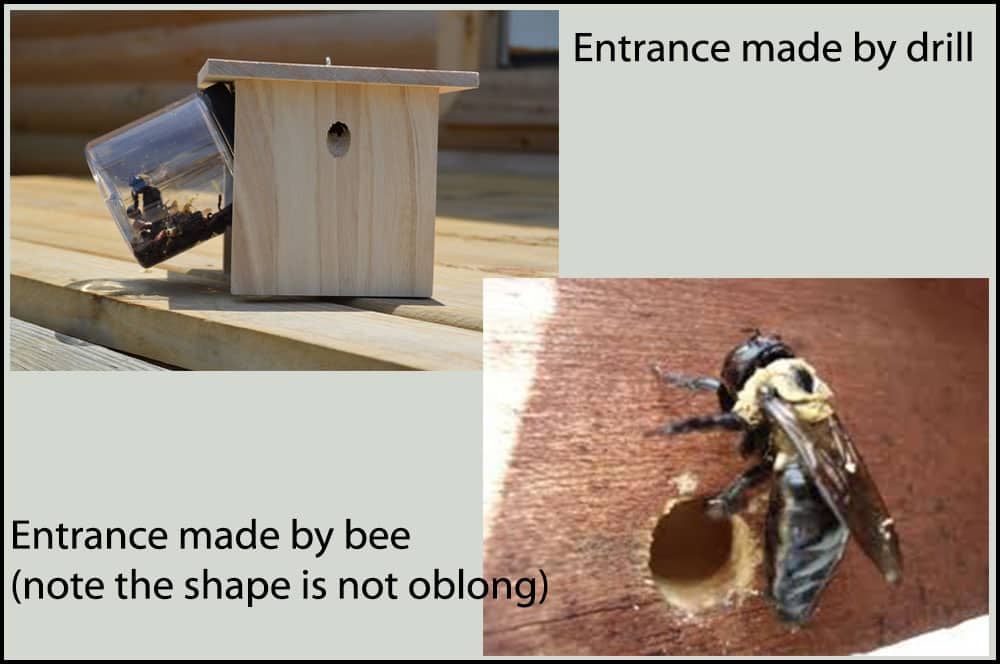
It’s that time of year again! Time to step out on the front porch of your home, sip from your nice cup of coffee, and take in the relaxing early summer air.
That is, of course, unless you were like me this morning, staring at bits of wood dust in the fresh cup of coffee. Looking up to find a perfectly drilled 1/2″ diameter hole in my fascia, I realized a small area of my home’s stain coverage was lacking. This hole had I not known better, would have looked like it was drilled by a human builder with a particular purpose. So perfect, in fact, it looked like it was placed there by no ordinary drill bit, but a finely sharpened and amazingly clean-cutting drill bit. Yes, you guessed it. The Carpenter Bees are back again; but, this time we’re prepared!
There are several ways to keep these annoying little tunnel-burrowing buggers from destroying exposed areas of your home. While I have, in the past, taken a less environmentally sound approach of shooting them with sprays, or swatting them with badminton rackets, now I know better. These destructive critters are also a major contributor to flower pollination, and one of the main reasons our tomato plants, eggplants, and other vegetables, and many types of flowers continue to thrive. So, unless you are looking to help destroy the ecosystem, you might want to think about an alternative that keeps your home sound and keeps the Carpenter Bees away.
At CTLH, our approach was to construct a modified version of a bee trap idea, set up by unclesam at the Instructables website. His approach is effective; however, it also kills the bees. While the damage these bees produce is maddening, the alternative of having no bees (or food) is worse. So we have modified the design a bit. (Please continue reading to the end of this article for instructions on building a perfect bee house.) We also added some “Bug Juice” to our topcoat of stain, and now we are back up and running.
The trick is giving these bees an easier alternative to drilling your home. Freshly cut wood or raw untreated ends of wooden planks, are what they look for first. They prefer pre-drilled holes, and will drill deeper to nest and lay their eggs. That is why our bee house uses pre drilled holes. The value of a bee house is two-fold: it gives the bees a great alternative to drilling into your home, and it can be a teaching tool for anyone asking for advice for their own Carpenter Bee problem.
Another effective remedy for ridding your home of Carpenter Bees is an additive called “Bug Juice.” “Bug Juice,” an EPA registered insecticide, is an excellent additive that can be added into the top, or last, coat of sealer or stain. It will not affect the stain’s color or drying time. “Bug Juice” comes in two sizes, to accommodate both large and small jobs.
While we receive no income from the sale of “Bug Juice,” we are enthusiastic about its effectiveness. You may purchase “Bug Juice” at http://www.wwenvironmental.com/. Tell them CTLH sent you!
Also, be sure to give these bees an easier alternative. Directions for building a Bee House are listed below.
How to build an awesome Bee Home:
Materials:
1. Left-over small block of EWP or Doug Fir rafter from one of our log home packages is ideal for this job! If you don’t have any, you can simply use a solid block of raw wood.
Construction:
1. Drill small holes in the block, at an upwards angle and spaced a few inches apart.
2. For Carpenter Bees a 1/2″ diameter hole of about 5-6″ in depth, drilled up under the lip of the overhang area, works well. Leafcutter bees use a 1/4″ hole and should be 2.5-4″ deep.
3. Drill these holes at an upwards angle and be sure not to go all the way through the block. Next year the bees will typically build in the same hole, but will often make it deeper and nest with less effort.
4. Attach an overhang roof piece to the block of wood, as the combination of upwards drilled angle and roof overhang make for a more desirable location for the bees.
5. Place the block at least three feet off of the ground, and where it will face southeast, allowing it to get morning sun.
After the bee season is over, be sure to remove the block and have it ready for next year. DON’T PUT THESE IN YOUR HOME! It is best to store them in a shed or outdoor area out of the way until needed next season.
Hopefully, this will help both your home and the bee population at the same time.
UPDATE: 5-12-15
A few keys we have noticed over the last year:
1. The overhang area is essential to the trap working as it should. Without a “roof” structure to keep the rain out of the holes, they aren’t as inclined to use the existing holes.
2. Upon further inspection of the best working traps, the holes drilled by the bees are very precise. Most of these are perfectly round, so drilling on flat wood at an upward angle doesn’t work as well as angled wood with a flat hole (see image below)
3. Another method is to lure the bees to another location, or one where they will have less work to make into a suitable home. An example of a “Bee Hotel” is starting to gain traction. Due to the destructive nature of killing these pollinators, and because the food chain, killing humanity, epic crises, etc., we don’t like killing them. But, when they start destroying our homes; it’s fair game in our opinion. The bee hotel MAY be the best of both worlds though we haven’t tried it yet. If you do, please let us know how it works for you!



